What do Vita Longa and Bangor F1 carrots have in common?
Carrot crops Vita Longa and Bangor F1 are grown on large farms and in gardens. In regions with difficult climatic conditions, it produces consistently high yields of sweet root crops with good shelf life.
Description of Dutch carrots Vita Longa and Bangor F1
The Vita Longa variety and Bangor F1 hybrid carrots have been created breeders of the Dutch agronomic company Bejo Zaden.
 For Vita Long, the period from full germination to harvesting is 160 days. Carrots belong to the Chantane variety.
For Vita Long, the period from full germination to harvesting is 160 days. Carrots belong to the Chantane variety.
Produces uniform orange roots with smooth skin:
- medium length – up to 15 cm;
- diameter 4-6 cm;
- in shape – blunt-ended or slightly pointed;
- with a dry matter content of 10-11%, including total sugar 7-8%
- containing provitamin A – 9-12 mg per 100 g of raw material.
Characterized by good keeping quality and high commercial yield - 83-95%.
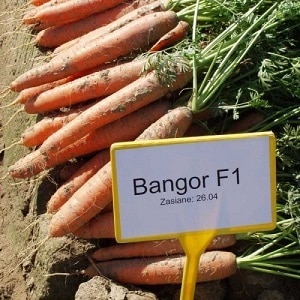 The hybrid Bangor F1 has a growing season of 110 days. Root crops are distinguished by uniformity and high commercial qualities.
The hybrid Bangor F1 has a growing season of 110 days. Root crops are distinguished by uniformity and high commercial qualities.
Belongs to the Berlikumer variety.
Distinctive features:
- peel and core color – orange;
- fruit length – 20-25 cm, diameter 3-5 cm;
- yield of marketable products 75-90%;
- contains 10.5% dry matter, of which 6% total sugars;
- provitamin A – 10 mg per 100 g of raw material.
Both varieties produce juicy root vegetables, which are suitable for processing into juices, for drying and fresh consumption.
Main characteristics of the Vita Longa variety and the Bangor F₁ hybrid:
| Name | Ripening period | Root weight, g | Productivity per hundred square meters, kg | Regions of admission | Sustainability |
| Vita Longa | Mid-season | 100-350 | 200-490 | Northwestern, Central, Volga-Vyatka, Central Black Earth, Middle Volga, Lower Volga, Ural, Siberia, Far Eastern | Alternaria blight |
| Bangor F₁ | Early ripening | 120-350 | 196-270 | Northern, Northwestern, Central, Volga-Vyatka, Ural, Siberia, Far Eastern | Cercospora |
During mechanized harvesting The leaf petioles of this carrot are not damaged.
The variety and hybrid are characterized by high resistance to bacterial diseases.
The main advantages and disadvantages of Vita Long and Bangor F1
The root crop of the Vita Longa variety has a thin core – its diameter of the total diameter is less than 30%. Root crops protrude slightly above the soil surface. The variety is highly resistant to brown leaf spot.
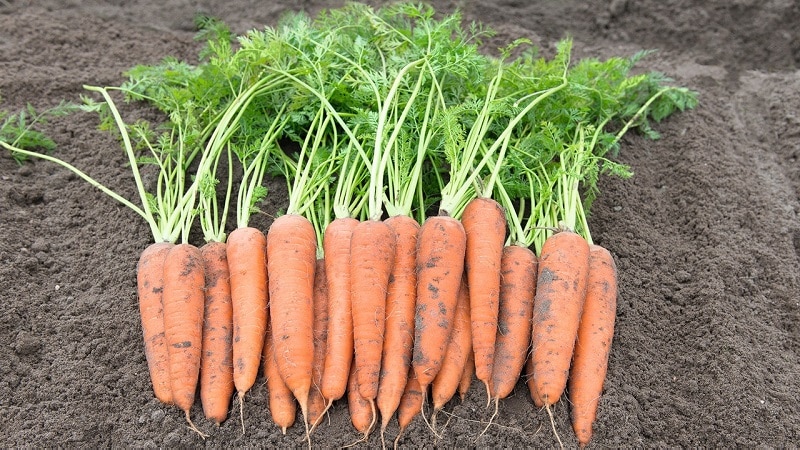
Bangor F₁ produces smooth, uniform root crops of equal length. It is characterized by 100% keeping quality during long-term storage. Over a large feeding area, it grows root crops weighing 400-500 g.
The variety and hybrid have persistent resistance to greening of root crops. Gardeners did not identify any shortcomings when growing them.
Features of planting and growing
Any soil is suitable, except clean sand and heavy clay. The highest yields are obtained on light loamy soils and peat bogs.
Manure is applied a year before planting the predecessor crop. – cabbage, potatoes, tomatoes, cucumbers, legumes. It is not recommended to grow carrots after perennial herbs and representatives of the Apiaceae family - parsley, dill, celery. These crops are parasitized by the carrot fly and pathogens dangerous to carrots - the causative agents of white rot, Alternaria blight, and brown spot.
For carrots, a deep arable layer is formed, in which the root crop will develop:
- clear the area of stones;
- dig up the soil to a depth of 25-27 cm;
- loosen to ensure the flow of air and underground moisture to the root crops.
Phosphorus-potassium fertilizers are applied during autumn digging. Nutrients are available to carrots when the soil reaction is slightly acidic (pH 6.5).
Important! 10 days before planting, the seeds are placed in a canvas bag and buried on the site in moist soil. Then they are taken out, dried for half an hour at room temperature and sown.
Dutch carrot seeds can be soaked in one of the solutions heated to 30°C:
- for 1 liter of water – 1/3 tsp. boric acid and 1/2 tsp. nitroammofoski;
- 1 liter of water, potassium permanganate, 1/2 tsp. fertilizers;
- 1 liter of water and 1 tbsp. l. wood ash.
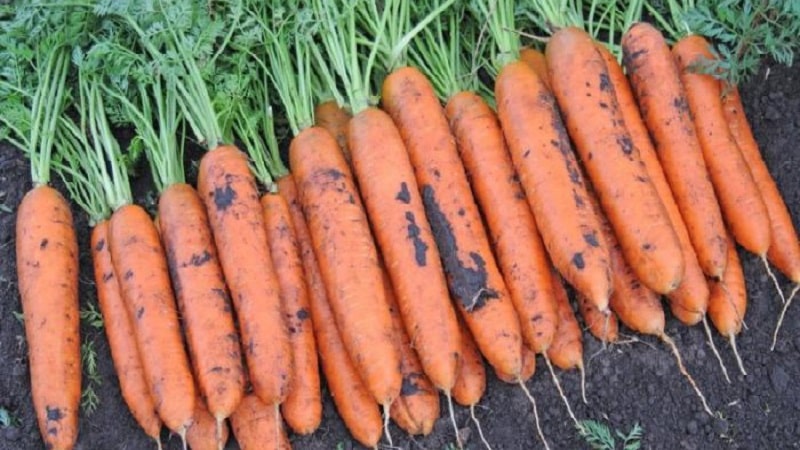
After a day, the seeds are rinsed, wrapped in a damp cloth and placed in the refrigerator for 3-4 days. Then they are taken out, slightly dried and sown.
Sowing time depend on the weather. The minimum temperature for seed germination is +4…+6°С, the optimal temperature is +18…+20°С. Towards spring sowing They begin as soon as the soil dries up, and start wintering - 2 weeks before frost.
Seeding rate per 1 m² – 100 seeds. The seeding depth on heavy soils is 1-1.5 cm, on light soils 2.5-3.5 cm. In regions with dry springs, seeds are buried to a depth of 5 cm.
They are sown in the beds in furrows located at a distance of 20 cm from each other, or using the tape method: the distance between the tapes is 30-45 cm, between the rows 18-20 cm.
Early maturing hybrid Bangor F₁ is grown in ridges, which are cut in the fall. In spring, the soil in the ridges quickly ripens at a depth of 15-20 cm, which allows for quick sowing and an early harvest.
Nuances of care
Shoots appear on 6-20 days. After watering or rain, the soil between the rows is loosened to a depth of 3 cm, trying to prevent the formation of a crust. At the same time, weeds are destroyed.
Thinning begins when the carrots have 1-2 true leaves. Leave a gap of 3-4 cm between the plants, compact the soil around the root and water with warm water.
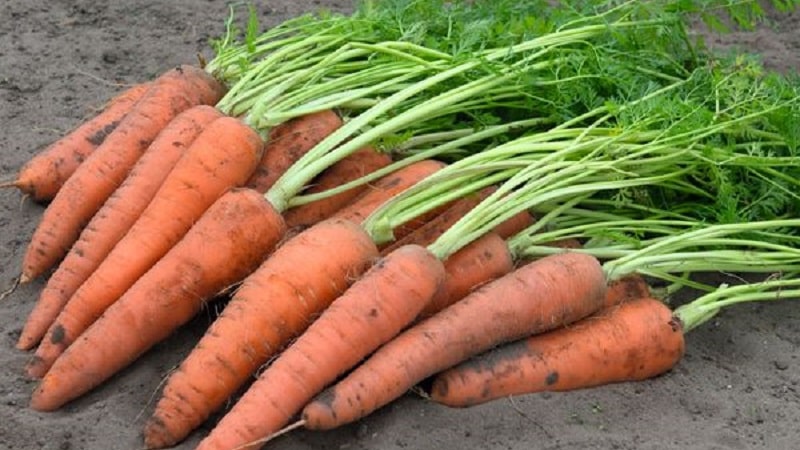
Long-fruited carrots require careful attention to watering:
- young shoots are watered 1-2 times a week at 3-4 l/m²;
- root vegetables the thickness of a pencil – once a week, 10 l/m²;
- for larger root crops, increase water consumption to 20 l/m².
Alternating dry periods with abundant watering leads to cracking of carrots.A month after germination, the first fertilizing is done. – dilute 1 tbsp in 10 liters of water. l. nitrophoska. 5 liters of solution are consumed per 1 m². After 2.5 weeks, fertilizing is repeated - 7-8 l/m².
The most dangerous pests and diseases:
- carrot fly It is especially dangerous in wet areas located near bushes and on peaty and swampy soils. The leaves turn bronze and die. Covering crops with non-woven material in the phase of appearance of true leaves is effective against carrot flies. Treated with Decis Profi and Tsiper.
- carrot psyllid distributed in areas near coniferous forests. Carrot leaves dry out. Plants are sprayed with tobacco dust or soap solution.
- Sources of infection black rot – soil, weeds and seeds. The main symptom is blackening of the stem. The petioles tend to the ground. Spraying with the preparation "Rovral" is used.
- Brown spot spreads through weeds and infected seeds.Brown constrictions appear on the lower part of the stem, yellow spots on the leaves. Plants are treated with a decoction of celandine or horsetail.
- Pathogens cercospora transmitted through plant debris. Light brown spots with a light center, covered with plaque, appear on the leaves. For prevention, treat with a weak solution of Bordeaux mixture.
General preventive measures include following crop rotation, deep autumn digging of the soil and destruction of plant debris, especially weeds of the Celery family.
Harvest and storage
The safety of Vita Long is 93%, Bangor F₁ is 96-98%. Harvesting of mature root crops begins before the onset of autumn frosts.
Conditions for long-term preservation of root crops:
-
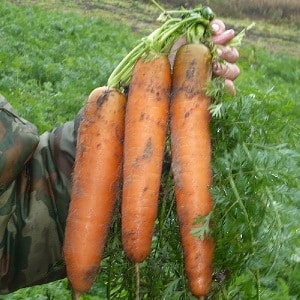 Carrot Bangor F1
Carrot Bangor F1grown on soils with low organic matter content;
- fully ripened, harvested without damage, residues of tops, or signs of disease;
- collected in dry weather, dried, not washed;
- before storing in storage they were cooled to +6...+8°C for 1-2 days.
Optimal storage conditions for carrots: temperature +1…+2°C, relative humidity 98%.
Carrots are stored in the basement in boxes, under a layer of sand, to which chalk or slaked lime is added - 1-2%. This allows root vegetables to retain moisture and protects them from diseases. As the sand dries, it is moistened. 100 kg of carrots require 3-4 kg of sand.
Roots keep well in open-top plastic bagsinstalled vertically.
What difficulties may there be when growing
If the root was formed during a dry period, the main root dies, and the growth of lateral roots accelerates. The result is a root crop that is capitate or has a thickened upper part.
Deformed fruits grow in sparse crops with a huge feeding area and overfeeding with nitrogen fertilizers. During the period when the root begins to deposit nutrients, drought and shallow watering are dangerous. The plant grows lateral roots in search of moisture. At this time, you need to water the carrots generously, trying to ensure that the moisture penetrates deep into the soil.
Advice from experienced gardeners
Gardeners with extensive experience in growing carrots of the Vita Longo variety and the Bangor F₁ hybrid to obtain smooth and even root crops it is recommended:
- apply manure a year, preferably two, before planting carrots;
- create loose fertile arable soil 30 cm deep.
The bed is covered with non-woven material immediately after sowing. In this case, the seedlings are not afraid of the soil crust that forms 2-3 days after the rains.
Plantings after germination are not watered for a weekto allow the root to go down and strengthen.
Reviews of carrots Vita Longa and Bangor F₁
Gardeners leave positive reviews about Bangor F1 and Vita Longa carrots.
Nina, Pskov: “I have been planting the Vita Longa variety for several years. I sow at the end of May in furrows. I immediately mulch with peat and cover with spunbond. If I use film, I leave a gap of 10-15 cm between the bed and the shelter so that the crops do not suffocate. Shoots appear early and the soil does not dry out.".
Dmitry, Saratov: “Bangor F₁ was recommended by a neighbor in the country. The carrots turn out excellent - large, juicy, and can be stored all winter. I advise you not to keep it in the ground. If you are late with cleaning, it becomes covered with cracks and loses its taste.”.
Conclusion
Carrots of the Vita Longa variety and the Bangor F₁ hybrid are distinguished by their vigorous germination, disease resistance, and suitability for long-term storage.Dutch carrot varieties for central Russia produce equally stable and high yields in the cool northern regions, in Siberia with contrasting seasons, and in the monsoon climate of the Far East.